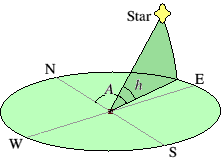
 Astronomical Object Finder Astronomical Object Finder |

 Astronomical Object Finder Astronomical Object Finder |
 From an observer's point of view, a more convenient means of specifying
positions is by the so called 'alt-azi' system. These alternative
co-ordinates are 'altitude' (angle object makes from the observer's
horizon) and 'azimuth' (angle from the observer's North). The altitude
(h) and azimuth (A) are shown in the figure (in which the observer is
at the centre). The drawback of this co-ordinate system is that h and
A are time dependent and vary with the observer's location on Earth.
From an observer's point of view, a more convenient means of specifying
positions is by the so called 'alt-azi' system. These alternative
co-ordinates are 'altitude' (angle object makes from the observer's
horizon) and 'azimuth' (angle from the observer's North). The altitude
(h) and azimuth (A) are shown in the figure (in which the observer is
at the centre). The drawback of this co-ordinate system is that h and
A are time dependent and vary with the observer's location on Earth.

